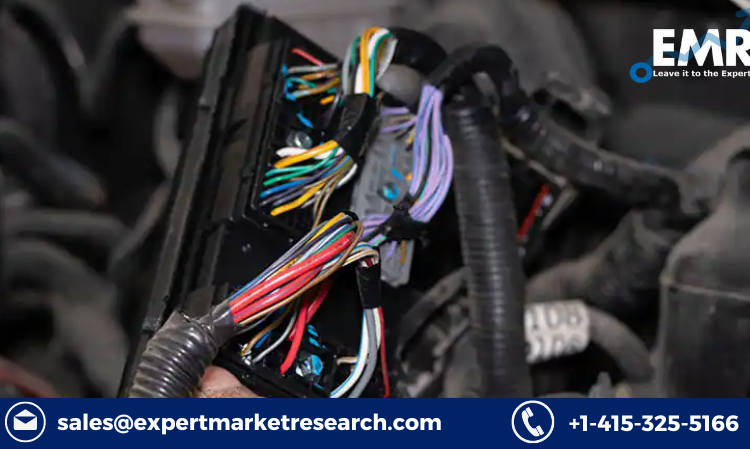In an era where the automotive industry continues to evolve at a breathtaking pace, driven by technological advancements and consumer demands, certain elements remain integral to vehicle functionality. One such element is the automotive wiring harness, a critical component that assures a vehicle’s proper electrical functioning. The global automotive wiring harness market is expected to grow at a compound annual growth rate (CAGR) of 6.2% in the forecast period of 2023-2028, indicating a flourishing future for this sector. So, let us delve into the intricacies of this thriving market.
Overview
The automotive wiring harness, commonly referred to as a cable harness, comprises a bundle of electrical wires, cables, and connectors used to transmit information and electric power in automobiles. These systems play a crucial role in connecting various electrical and electronic components of a vehicle, ensuring a smooth flow of power among them. The complexity of these harnesses can vary significantly depending on the vehicle’s type and its electrical requirements.
Components
The primary components of an automotive wiring harness include:
Wires and Cables: These serve as the conductive pathways to transmit power or information. The selection of wires and cables depends on factors like current-carrying capacity, durability, and cost.
Connectors: These are used to link the wiring harness to various electrical and electronic components in the vehicle. Connectors must be sturdy, resistant to vibration, and capable of handling the required electrical load.
Terminals: These are the points at which the wires connect to the electrical components. Terminals must be resistant to corrosion and capable of maintaining a secure connection.
Protective Sheathing: This outer layer is designed to protect the wiring harness from damage due to factors like vibration, friction, moisture, and heat.
Market Segmentation
The automotive wiring harness market can be segmented based on vehicle type, application, material type, and region.
By Vehicle Type: 1. Passenger cars
2. commercial vehicles
3. electric vehicles.
By Application: Engine, chassis, sensors, heating, ventilation, and air conditioning (HVAC), among others.
By Material Type: Copper, aluminum, and others.
By Region: North America, Europe, Asia-Pacific, Latin America, and Middle East & Africa.
The passenger car segment held a significant market share due to high demand, while the engine application segment is expected to show robust growth in the forecast period. Copper, with its excellent electrical properties, is the predominant material used.
Benefits and Applications
Automotive wiring harnesses provide several benefits:
Simplified Installation: They provide organized connectivity, easing the process of assembly and installation.
Enhanced Safety: By reducing the risk of short circuits, they contribute to improved vehicle safety.
Cost and Space Efficiency: They provide an effective solution for the compact arrangement of wires, saving space and reducing overall vehicle cost.
These harnesses find applications in various vehicle systems, including lighting, audio systems, power windows and doors, air conditioning systems, and advanced driver-assistance systems (ADAS).
Factors Driving Growth
Several factors are fueling the growth of the automotive wiring harness market:
Increase in Vehicle Production: Rising vehicle production, especially electric vehicles, contributes to the growing demand for wiring harnesses.
Technological Advancements: The incorporation of advanced features in vehicles, such as navigation, infotainment, and driver-assistance systems, require complex wiring systems, boosting the market.
Stringent Safety Regulations: Regulatory bodies enforcing safety norms necessitate the use of high-quality wiring harnesses.
Challenges and Barriers
Despite its promising growth, the market faces certain challenges:
Fluctuating Raw Material Prices: The fluctuating prices of copper and plastic, key materials for making wiring harnesses, pose a challenge.
Complexities in Design: The increased integration of electronic systems in vehicles has made the design and manufacturing of wiring harnesses more complex.
Market Opportunities and Future Outlook
The automotive wiring harness market holds promising prospects. Opportunities lie in areas such as:
Electric Vehicles (EVs): The EV market’s exponential growth provides opportunities for harness manufacturers due to the increased complexity of EV wiring systems.
Autonomous Vehicles: The rise of autonomous vehicles, with their advanced electrical systems, will require sophisticated wiring harnesses.
Emerging Markets: Developing economies, with increasing vehicle production and demand, present lucrative opportunities.
Given these factors, the future outlook for the automotive wiring harness market is positive, with expected growth in line with advancements in automotive technology. It is clear that as the automotive industry continues to evolve, the wiring harness market will stride alongside, powering the future of mobility.
Navigating through the competitive landscapes of the automotive industry, the wiring harness market stands out as a critical area shaping the sector’s trajectory. As we advance towards more interconnected, smart, and electric vehicles, the importance and demand for high-quality automotive wiring harnesses will continue to accelerate, driving this market towards promising horizons.







